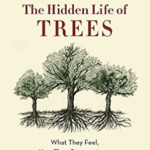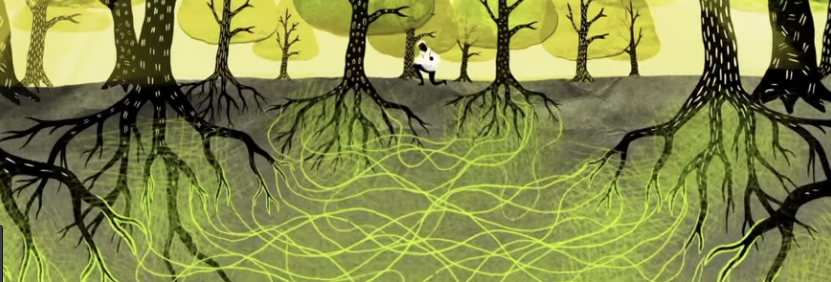Peter Wohlleben’s book reinforces and expanded some of my thoughts as it tells  about trees and their tight-knit communities in the forest.
about trees and their tight-knit communities in the forest.
Plants and trees don’t have brains and that’s enough, for some, to settle in the negative whether they sense, evaluate, think, learn, plan, act or feel. But there has been a explosion of interest in what is sometimes called plant “neurobiology. Trees speak a sophisticated silent language, communicating complex information via smell, taste, touch and electrical impulses. Communities of trees can work together to defend themselves against a common threat.
The Wood Wide Web is a community of trees and microbes, aphids, fungi and birds, one in which dense connectivity and mutual interdependence are the norm (and are missing in the forest-farms of the modern world). Communication, shared and competing interests, learning and adaptation, all play a critical role. Even personality, or character, are in evidence in the forest. There may be two oak trees, side by side, one of which opts to shed its leaves at the first sign of weather change and, so, to protect itself against autumnal winds and weighty falls of ice and snow — and the other of which holds on and takes advantage of late heat waves to store up more sugar for the long winter ahead. Same soil, same air, same needs, same species, but different choices. Individual trees, like individual people, have different characters, or so Wohlleben would have it.
Four decades ago, scientists noticed something on the African savannah. The giraffes were feeding on umbrella thorn acacias, and the trees didn’t like this one bit. It took the acacias mere minutes to start pumping toxic substances into their leaves to rid themselves of the large herbivores. The giraffes got the message and moved on to other trees in the vicinity. The giraffes then walked right by a few trees and resumed their meal only when they had moved about 100 yards away.
The reason for this behavior is astonishing. The acacia trees that were being eaten gave off a warning gas (specifically, ethylene) that signaled to neighboring trees of the same species that a crisis was at hand. Right away, all the forewarned trees also pumped toxins into their leaves to prepare themselves. The giraffes understood this and therefore moved farther away to a part of the savannah where they could find trees that were oblivious to what was going on. Or else they moved upwind. For the scent messages are carried to nearby trees on the breeze, and if the animals walked upwind, they could find acacias close by that had no idea the giraffes were there.
“In the case of Switzerland, a whole country is concerned with the species-appropriate treatment of all things green. The constitution reads, in part, that “account [is] to be taken of the dignity of creation when handling animals, plants and other organisms.”
As the capabilities of vegetative beings become known, and their emotional lives and needs are recognized, then the way we treat plants needs to change. Non-human (plant) consciousness is not science fiction but current research: some going back many years. Organisms without a brain (trees) who seem able to remember and learn.
Perhaps we need to rethink we redefine our relationships and life?

Image from http://thekidshouldseethis.com/post/the-wood-wide-web-how-trees-secretly-talk-to-and-share-with-each-other copied Aug. 2018
Lisa
August 31, 2018
I love this book! It’s provided so much inspiration for my novel!